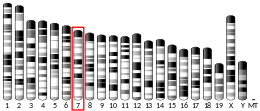KCNC1
KCNC1| KCNC1 | |||||||||||||||||||||||||
|---|---|---|---|---|---|---|---|---|---|---|---|---|---|---|---|---|---|---|---|---|---|---|---|---|---|
| 식별자 | |||||||||||||||||||||||||
| 별칭 | KCNC1, KV3.1, KV4, NGK2, EPM7, 칼륨 전압 게이트 채널 서브 패밀리 C 멤버 1 | ||||||||||||||||||||||||
| 외부 ID | OMIM: 176258 MGI: 9667 HomoloGene: 68134 GeneCard: KCNC1 | ||||||||||||||||||||||||
| |||||||||||||||||||||||||
| |||||||||||||||||||||||||
| |||||||||||||||||||||||||
| |||||||||||||||||||||||||
| 직교체 | |||||||||||||||||||||||||
| 종 | 인간 | 마우스 | |||||||||||||||||||||||
| 엔트레스 | |||||||||||||||||||||||||
| 앙상블 | |||||||||||||||||||||||||
| 유니프로트 | |||||||||||||||||||||||||
| RefSeq(mRNA) | |||||||||||||||||||||||||
| RefSeq(단백질) | |||||||||||||||||||||||||
| 위치(UCSC) | Chr 11: 17.73 – 17.86Mb | Cr 7: 46.05 – 46.09Mb | |||||||||||||||||||||||
| PubMed 검색 | [3] | [4] | |||||||||||||||||||||||
| 위키다타 | |||||||||||||||||||||||||
| |||||||||||||||||||||||||
칼륨 전압 게이트 채널 서브 패밀리 C 멤버 1은 인간에서 KCNC1 유전자에 의해 인코딩되는 단백질이다.[5][6][7]
드로소필라의 셰이커 유전자 계열은 전압 게이트 칼륨 채널의 성분을 암호화하고 4개의 하위 패밀리로 구성된다.시퀀스 유사성에 근거하여, 이 유전자는 이러한 하위 가족들 중 하나인 쇼 하위 가족과 유사하다.이 유전자가 인코딩한 단백질은 채널 단백질의 지연 정류기 등급에 속하며, 흥분성 막의 전압 의존성 칼륨 이온 투과성을 매개하는 일체형 막 단백질이다.[7]
표현 패턴
K3v.1과 K3v.2 채널은 고주파에서 발화하는 뉴런에서 두드러지게 표현된다.K3v.1 채널은 뇌(세레벨럼 > globus palidus, subthalamic nucleus, substalamic nucleus, mercentia nigra > 망상골신경세포, 피질 및 해마내외핵)에서 두드러지게 표현된다.[8][9][10]
생리적 역할
K3v.1/K3v.2 전도성은 고주파수 작용 전위 발생에 대해 운동적으로 최적화되어야 한다.[9][11]K3v.1 채널은 청각 및 빠른 스피킹 GABAergic 내부 동맥류, 망막 갱내 세포의 고화력 주파수, 사전 시냅스 단자의 작용 전위 지속시간 조절에 중요하다.[8][10]
약리학적 특성
이단계의 K3v.1 전류는 외부 테트라에틸람모늄(TEA) 또는 4-아미노피리딘(4-AP)에 매우 민감하다(IC50 값은 각각 0.2mM, 29μM).[9][10]이것은 네이티브 채널을 식별하는 데 유용할 수 있다.[9]0.5 mM TEA와 30 μM 4-AP 모두에 대한 칼륨 전류의 중복 감도는 K3v.1 서브유닛에 대한 작용을 강하게 시사한다.[12]
대본 변형
K3v.1유전자에는 K3v.1a와 K3v.1b라는 두 가지 대본변형이 있다. K3v.1의 이소형태는 C단말 순서에서만 다르다.[13]
임상적 유의성
오식 변이 c.959G>A(p)KCNC1의 Arg320His)는 진행성 근막간질을 유발한다.[14]
참고 항목
참조
- ^ a b c GRCh38: 앙상블 릴리스 89: ENSG00000129159 - 앙상블, 2017년 5월
- ^ a b c GRCm38: 앙상블 릴리스 89: ENSMUSG000058975 - 앙상블, 2017년 5월
- ^ "Human PubMed Reference:". National Center for Biotechnology Information, U.S. National Library of Medicine.
- ^ "Mouse PubMed Reference:". National Center for Biotechnology Information, U.S. National Library of Medicine.
- ^ Ried T, Rudy B, Vega-Saenz de Miera E, Lau D, Ward DC, Sen K (Apr 1993). "Localization of a highly conserved human potassium channel gene (NGK2-KV4; KCNC1) to chromosome 11p15". Genomics. 15 (2): 405–11. doi:10.1006/geno.1993.1075. PMID 8449507.
- ^ Gutman GA, Chandy KG, Grissmer S, Lazdunski M, McKinnon D, Pardo LA, Robertson GA, Rudy B, Sanguinetti MC, Stuhmer W, Wang X (Dec 2005). "International Union of Pharmacology. LIII. Nomenclature and molecular relationships of voltage-gated potassium channels". Pharmacol Rev. 57 (4): 473–508. doi:10.1124/pr.57.4.10. PMID 16382104. S2CID 219195192.
- ^ a b "Entrez Gene: KCNC1 potassium voltage-gated channel, Shaw-related subfamily, member 1".
- ^ a b Kolodin YO (2008-04-27). "Ionic conductances underlying excitability in tonically firing retinal ganglion cells of adult rat". Retrieved 2008-10-20.
- ^ a b c d Rudy B, McBain CJ (September 2001). "Kv3 channels: voltage-gated K+ channels designed for high-frequency repetitive firing". Trends in Neurosciences. 24 (9): 517–26. doi:10.1016/S0166-2236(00)01892-0. PMID 11506885. S2CID 36100588.
- ^ a b c Gutman GA, Chandy KG, Grissmer S, Lazdunski M, McKinnon D, Pardo LA, Robertson GA, Rudy B, Sanguinetti MC, Stühmer W, Wang X (December 2005). "International Union of Pharmacology. LIII. Nomenclature and molecular relationships of voltage-gated potassium channels". Pharmacological Reviews. 57 (4): 473–508. doi:10.1124/pr.57.4.10. PMID 16382104. S2CID 219195192.
- ^ Lien CC, Jonas P (March 2003). "Kv3 potassium conductance is necessary and kinetically optimized for high-frequency action potential generation in hippocampal interneurons". Journal of Neuroscience. 23 (6): 2058–68. doi:10.1523/JNEUROSCI.23-06-02058.2003. PMC 6742035. PMID 12657664.
- ^ Dallas ML, Atkinson L, Milligan CJ, Morris NP, Lewis DI, Deuchars SA, Deuchars J (February 2005). "Localization and function of the Kv3.1b subunit in the rat medulla oblongata: focus on the nucleus tractus solitarii". The Journal of Physiology. 562 (Pt 3): 655–72. doi:10.1113/jphysiol.2004.073338. PMC 1665536. PMID 15528247.
- ^ Rudy B, Chow A, Lau D, Amarillo Y, Ozaita A, Saganich M, Moreno H, Nadal MS, Hernandez-Pineda R, Hernandez-Cruz A, Erisir A, Leonard C, Vega-Saenz de Miera E (April 1999). "Contributions of Kv3 channels to neuronal excitability". Annals of the New York Academy of Sciences. 868 (1): 304–43. Bibcode:1999NYASA.868..304R. doi:10.1111/j.1749-6632.1999.tb11295.x. PMID 10414303. S2CID 25289187.
- ^ Muona M, Berkovic SF, Dibbens LM, Oliver KL, Maljevic S, Bayly MA, Joensuu T, Canafoglia L, Franceschetti S, Michelucci R, Markkinen S, Heron SE, Hildebrand MS, Andermann E, Andermann F, Gambardella A, Tinuper P, Licchetta L, Scheffer IE, Criscuolo C, Filla A, Ferlazzo E, Ahmad J, Ahmad A, Baykan B, Said E, Topcu M, Riguzzi P, King MD, Ozkara C, Andrade DM, Engelsen BA, Crespel A, Lindenau M, Lohmann E, Saletti V, Massano J, Privitera M, Espay AJ, Kauffmann B, Duchowny M, Møller RS, Straussberg R, Afawi Z, Ben-Zeev B, Samocha KE, Daly MJ, Petrou S, Lerche H, Palotie A, Lehesjoki AE (2015). "A recurrent de novo mutation in KCNC1 causes progressive myoclonus epilepsy". Nature Genetics. 47 (1): 39–46. doi:10.1038/ng.3144. PMC 4281260. PMID 25401298.
추가 읽기
- Kimura K, Wakamatsu A, Suzuki Y, et al. (2006). "Diversification of transcriptional modulation: large-scale identification and characterization of putative alternative promoters of human genes". Genome Res. 16 (1): 55–65. doi:10.1101/gr.4039406. PMC 1356129. PMID 16344560.
- Ota T, Suzuki Y, Nishikawa T, et al. (2004). "Complete sequencing and characterization of 21,243 full-length human cDNAs". Nat. Genet. 36 (1): 40–5. doi:10.1038/ng1285. PMID 14702039.
- Devaux J, Alcaraz G, Grinspan J, et al. (2003). "Kv3.1b is a novel component of CNS nodes". J. Neurosci. 23 (11): 4509–18. doi:10.1523/JNEUROSCI.23-11-04509.2003. PMC 6740813. PMID 12805291.
- Strausberg RL, Feingold EA, Grouse LH, et al. (2003). "Generation and initial analysis of more than 15,000 full-length human and mouse cDNA sequences". Proc. Natl. Acad. Sci. U.S.A. 99 (26): 16899–903. doi:10.1073/pnas.242603899. PMC 139241. PMID 12477932.
- Ottschytsch N, Raes A, Van Hoorick D, Snyders DJ (2002). "Obligatory heterotetramerization of three previously uncharacterized Kv channel alpha-subunits identified in the human genome". Proc. Natl. Acad. Sci. U.S.A. 99 (12): 7986–91. Bibcode:2002PNAS...99.7986O. doi:10.1073/pnas.122617999. PMC 123007. PMID 12060745.
- Xu J, Yu W, Jan YN, et al. (1995). "Assembly of voltage-gated potassium channels. Conserved hydrophilic motifs determine subfamily-specific interactions between the alpha-subunits". J. Biol. Chem. 270 (42): 24761–8. doi:10.1074/jbc.270.42.24761. PMID 7559593.
- Grissmer S, Ghanshani S, Dethlefs B, et al. (1992). "The Shaw-related potassium channel gene, Kv3.1, on human chromosome 11, encodes the type l K+ channel in T cells". J. Biol. Chem. 267 (29): 20971–9. doi:10.1016/S0021-9258(19)36784-5. PMID 1400413.
외부 링크
- Kv3.1+칼륨+채널(미국 국립 의학 라이브러리 의료 과목 제목)
- KCNC1+단백질,+인간(MeSH) 미국 국립 의학 도서관의 의학 과목 제목(MesH)
이 기사는 공공영역에 있는 미국 국립 의학 도서관의 텍스트를 통합하고 있다.







